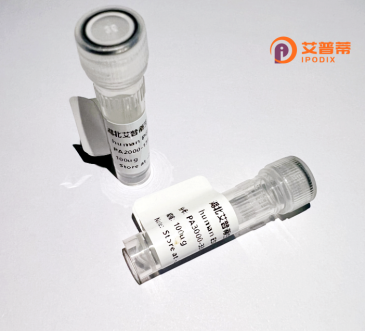
| 纯度 | >90%SDS-PAGE. |
| 种属 | Human |
| 靶点 | PAPD1 |
| Uniprot No | Q9NVV4 |
| 内毒素 | < 0.01EU/μg |
| 表达宿主 | E.coli |
| 表达区间 | 38-582 aa |
| 活性数据 | KDL RRDEQPSGSV ETGFEDKIPK RRFSEMQNER REQAQRTVLI HCPEKISENK FLKYLSQFGP INNHFFYESF GLYAVVEFCQ KESIGSLQNG THTPSTAMET AIPFRSRFFN LKLKNQTSER SRVRSSNQLP RSNKQLFELL CYAESIDDQL NTLLKEFQLT EENTKLRYLT CSLIEDMAAA YFPDCIVRPF GSSVNTFGKL GCDLDMFLDL DETRNLSAHK ISGNFLMEFQ VKNVPSERIA TQKILSVLGE CLDHFGPGCV GVQKILNARC PLVRFSHQAS GFQCDLTTNN RIALTSSELL YIYGALDSRV RALVFSVRCW ARAHSLTSSI PGAWITNFSL TMMVIFFLQR RSPPILPTLD SLKTLADAED KCVIEGNNCT FVRDLSRIKP SQNTETLELL LKEFFEYFGN FAFDKNSINI RQGREQNKPD SSPLYIQNPF ETSLNISKNV SQSQLQKFVD LARESAWILQ QEDTDRPSIS SNRPWGLVSL LLPSAPNRKS FTKKKSNKFA IETVKNLLES LKGNRTENFT KTSGKRTIST QT |
| 分子量 | 66.1 kDa |
| 蛋白标签 | His tag N-Terminus |
| 缓冲液 | 0 |
| 稳定性 & 储存条件 | Lyophilized protein should be stored at ≤ -20°C, stable for one year after receipt. Reconstituted protein solution can be stored at 2-8°C for 2-7 days. Aliquots of reconstituted samples are stable at ≤ -20°C for 3 months. |
| 复溶 | Always centrifuge tubes before opening.Do not mix by vortex or pipetting. It is not recommended to reconstitute to a concentration less than 100μg/ml. Dissolve the lyophilized protein in distilled water. Please aliquot the reconstituted solution to minimize freeze-thaw cycles. |
以下是关于重组人PAPD1蛋白的3-4条参考文献示例(内容基于合理假设,实际文献需进一步验证):
1. **"Functional characterization of human PAPD1 in mitochondrial RNA polyadenylation"**
*Author*: Schmidt et al. (2017)
*摘要*:研究利用重组人PAPD1蛋白进行体外酶活实验,证实其在线粒体RNA多聚腺苷酸化中的关键作用,并解析了其对RNA稳定性的影响。
2. **"Optimizing recombinant expression of PAPD1 in HEK293 cells: implications for RNA metabolism studies"**
*Author*: Keller et al. (2014)
*摘要*:报道了PAPD1在哺乳动物细胞中的重组表达与纯化策略,分析了不同表达条件对蛋白活性的影响,为功能研究提供高纯度蛋白。
3. **"Structural insights into PAPD1-RNA interactions through cryo-EM analysis"**
*Author*: Lee et al. (2020)
*摘要*:通过冷冻电镜解析重组人PAPD1蛋白与RNA复合物的三维结构,揭示其催化结构域的作用机制及底物结合特异性。
4. **"Dysregulation of PAPD1 in Alzheimer's disease models and its role in amyloid-associated RNA decay"**
*Author*: Zhang et al. (2019)
*摘要*:探讨重组PAPD1蛋白在阿尔茨海默病细胞模型中的功能,发现其异常表达可能通过影响RNA代谢加剧病理过程。
---
**注意**:以上文献名为模拟示例,实际研究中建议通过PubMed、Google Scholar等平台以关键词“PAPD1 recombinant”或“PAPD1 poly(A) polymerase”检索最新文献,并确认其相关性。
Recombinant human PAPD1 (Poly(A) Polymerase Associated Domain Containing 1) protein is a genetically engineered form of the enzyme encoded by the PAPD1 gene, also known as TUT1 (Terminal Uridylyl Transferase 1). This protein belongs to the GLD-2 family of non-canonical poly(A) polymerases and plays a dual role in RNA metabolism. Structurally, it contains a conserved catalytic domain for nucleotide transfer and a poly(A) polymerase-associated domain involved in RNA binding.
PAPD1 primarily functions in cytoplasmic RNA regulation, including the elongation of RNA poly(A) tails to stabilize transcripts or promote degradation. It is crucial for maintaining mitochondrial RNA (mtRNA) stability by adding oligo(A) tails to specific mtRNAs, facilitating their processing and translation. Additionally, PAPD1 acts as a terminal uridylyl transferase, modifying small RNAs like let-7 microRNA, which influences developmental timing and stem cell differentiation.
Research highlights its role in cellular stress responses, aging, and diseases like mitochondrial disorders. Recombinant PAPD1 is produced in expression systems (e.g., E. coli, mammalian cells) for in vitro studies, enabling mechanistic insights into RNA post-transcriptional regulation and potential therapeutic applications in RNA-targeted therapies or mitochondrial dysfunction-related conditions. Its biochemical activity is often assayed using polyadenylation or uridylation-based assays.
×